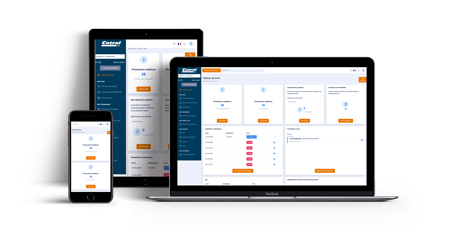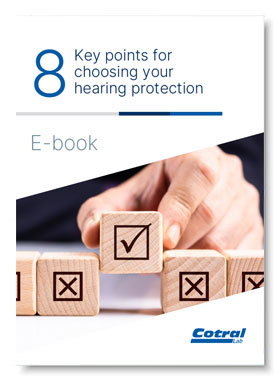The world of hearing protection has evolved a lot since the first custom hearing protection appeared in 1939. Discover these developments on video and decide which earplug best suits the needs of your employees.
Do you want to know more about custom-made hearing protection precisely adapted to your needs?
Video transcription:
Once upon a time there was hearing protection
A million years ago, the only significant noises were natural ones, like volcanoes and storms. At that time, man worked on the land, leading a simple and peaceful existence.
To improve his quality of life, he began to design all kinds of objects. To make them, he developed machines, each one noisier than the rest. But this wasn't without consequences.
Man naturally loses some hearing ability with age. Repeated exposure to high sound levels makes this hearing loss worse.
Since 1963, noise has been recognised as a cause of occupational disease. Legislation has established rules for daily noise, and particularly for workplace noise. A sound level above 80 dB(A) over a working day can cause hearing loss. So protection becomes mandatory.
Hearing protection timeline
In 1939, an American developed the first hearing protector. It was a porous latex earplug impregnated with petroleum jelly for easier insertion and removal.
In 1954, a preformed earplug designed to reduce violent noises was developed by Knighf.
In 1959, Rosenblatt developed the first ear defender with rubber earplugs.
The first silicone moulded earplug appeared in 1962.
In 1992, Cotral Lab began manufacturing custom-made hearing protectors. For 18 years, Cotral has manually produced silicone moulded earplugs. The process has been optimised, quality has been increased, one million people kitted out in 2007.
In order to offer high-performance products, Cotral undertook measures to determine the effectiveness of its protectors. The results didn't get beyond 75%. No matter how hard the engineers scratched their heads, carried out tests and further research, it was all in vain. Hearing protection had to be reinvented.
In 2007, work on digital manufacturing began.
In 2008, a bibliographic study conducted by Alain Kusy at INRS showed that custom-made protectors had average effectiveness variances of 7 decibels compared to certified values. Another study by HearingProTech showed that the effectiveness rate for custom-made protectors in relation to their average attenuation was only 70%.
The ear defender was 62%, the mouldable earplug was 31% and the effectiveness rate for the preformed earplug failed to get beyond 25%.
The custom-made protector could claim to be the most reliable, but is 70% or 75% effectiveness satisfactory?
Several years of development and research were needed to perfect this new technology: additive manufacturing, also called 3D printing. The first Cotral Lab custom-made hearing protectors, completely manufactured digitally, were made in 2010 with the Micra model. Once perfected, this new technology increased effectiveness from 75% to 84%.
In 2012, the Original White model with flat attenuation reached 91%. 95% was exceeded in 2014 with the new Qeos model.
Why does digital manufacturing allow this precision?
Manual manufacturing is based on the skill of the technicians who intervene directly on the impression. Because these manual operations aren't 100% repeatable from one operator to another, the precision variances were very often greater than 300 microns.
But with digital manufacturing, each step is perfectly repeatable. The process required several years of development. The impression is scanned in 3 dimensions and then digitally reworked. This modelling is meticulous and it's during this process that parameters are applied which will produce optimal effectiveness and comfort. The heart of Cotral Lab expertise.
The protectors are then constructed on a 3D machine. Here again, precision is paramount. Layer by layer, micron by micron, it takes over two hours to produce the product. The finish will then give it its shine, strength and bio-compatibility. All these processes produce excellent precision, which is now less than 100 microns.
How to choose a good custom hearing protector
The most important criteria are:
- Adaptation: it's essential to choose a hearing protector that's adapted to need, use and sound exposure levels of the person who's going to wear it.
- Effectiveness: when the attenuation level has been carefully determined, it's essential that the protector is reliable and that its level of effectiveness enables it to genuinely achieve the level specified by the manufacturer.
- Comfort: An uncomfortable protector won't be worn and all the effort made in selecting it will have been a waste of time.
- Training and raising awareness are an essential element for successful implementation and for ensuring that users understand why protection is imperative.
For adaptation, Cotral Lab has been using the SAPAN method since 2012 via the software of the same name developed by HearingProTech. Cotral Lab achieves an effectiveness level of 96% and guarantees under contract the effectiveness of all its protectors. The Visual Overlay system ensures optimal comfort for all our users.
Raising awareness among future wearers of hearing protectors is an integral part of the complete solution for employee hearing protection offered by Cotral. One-hour training modules can also be arranged.
Cotral Lab: About us
Cotral Lab has been based in the heart of Normandy since it was first established. It's a dynamic and innovative company and has been enjoying strong growth for over 20 years.
Cotral Lab has more than 200 employees, a local sales force, a worldwide presence on 5 continents, ISO 9001 certification since 2006, and an organisational structure aimed at companies that want to protect their employees who are exposed to noise.
Did you like this video? Please share it.


